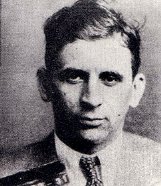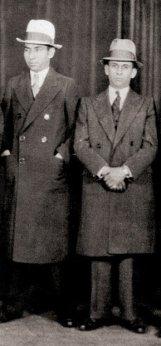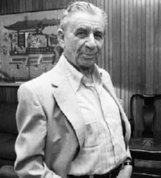- Home |
- About |
- Contact Us |
- RSS
Meyer Lansky - Gangster and Gambler
So called "accountant of the mob" who was both a math wizard and gambling mastermind.
Died: January 15, 1983 - Miami Beach, Florida

His family settled on Grand Street in the heart of New York's Lower East Side. Growing up in a Jewish neighborhood surrounded by Irish and Italian neighborhoods, Lansky quickly learned to stand up for himself. Despite his diminutive size, Lansky immediately established a reputation as someone who would always fight back whether or not he was outnumbered, outmatched or outsized by the wolf packs of boys from the surrounding neighborhoods praying on their Jewish victims.
Famously, as a young boy, Lansky fiercely defended himself against a group of older Sicilian youths who were roaming the neighborhood looking for Jewish boys to extort "protection" money from. The leader was so impressed with Lansky's tenacity and fearlessness in standing up to the group that the leader let Lansky off the hook. That day a life long bond of mutual admiration and respect was formed between the two, who in later years would become business partners and staunch allies. The leader of the Sicilians was a teenage Charles "Lucky" Luciano.
Another such tale of Lansky's integrity, strength, and pride in his identity, was when as a teenager he played basketball with a group of Irish boys who had the utmost respect for Lansky's skills as a ball player. Knowing that he was a Jew, the boys asked Meyer if they could call him by the name "Mike" so that none of the other kids would know he was Jewish. Meyer refused. Once again Lansky gained a high level of respect for standing up for himself and his identity.
Growing up in the Lower East Side, a teaming immigrant neighborhood, which at the time was a hotbed of corruption and vice, packed with brothels and gambling dens, both indoors and openly out on streets like Delancey and Rivington, Lansky quickly felt an affinity for the shady characters that roamed this world as well as the darker side of life and the art of turning a quick buck.
After finding himself on the wrong of end of con games at one of the open air gambling dens, Lansky resolved to make himself an expert in the ways of gambling. He soon discovered that with his combination of street smarts, leadership qualities, and incredible knack for mathematics, he could excel in gambling, along with other illegal activities. It was on these streets where as a teenager he met a wild-tempered teenager named Benjamin "Bugsy" Siegel, who Lansky took under his wings as a mentor of sorts.
By the early 1920s, Meyer along with Lucky Luciano and Bugsy Siegel, had become partners in various rackets including bootlegging, liquor hijackings, labor extortion and sluggings through strike breakings and protection rackets. Lansky and Siegel and their associates came to be known as the "Bug and Meyer Mob." Lansky also soon found a mentor in Arnold Rothstein. Rothstein recognizing a kindred spirit and genuine brains in Lansky and helped educate him on how to treat his criminal enterprises more like a true business rather than with the short sightedness of a street hoodlum.
In 1931, after helping his now business partner, Luciano, orchestrate the elimination of the leading "Mustache Petes" of the day, Big Joe Masseria and Salvatore Maranzano. Lansky, Luciano, Vito Genovese, Lepke Buchalter, Frank Costello, Joe Adonis, and Bugsy Siegel, all loosely partnered in Jewish/Italian coalition of organized criminals, who controlled most of the corruption and rackets in New York City and partnered with crime groups in most of the major American cities.
Lansky and Luciano's friendship, mutual admiration and respect led to a liberalizing of the unwritten set of laws governing inter-ethnic relations, which was one of the main reasons why they sought to remove the Mustache Petes--because of their narrow minded view that Italians should stick solely with Italians.
Variously referred to as The Syndicate, The Combination or the Big Five or Big Six, the idea was that crime should be treated like a business, in the manner in which Rothstein had taught them. No longer were tribal vendettas waged or territories encroached on, the group acting as a committee made communal decisions about whether an offense deserved the ultimate punishment or if there were alternative means to resolve grievances.
After prohibition's demise in 1933, Lansky set about diversifying his business operations, attempting to invest in both legitimate and illegitimate enterprises. His primary source of income, however, remained gambling. Throughout the 1930s, he opened up several "carpet joints" (meaning that they were so "fancy" that they had carpets), gambling locations in upstate New York, New Orleans, and Florida as well as began making inroads into gambling operations in Cuba. He also invested heavily in dog tracks in Hallendale, Florida, the base of his gambling universe.
Lansky's biggest innovation was that he never cheated his customers. He understood that since the odds are in the house’s favor, it made no sense to rip off the clientele, and Lansky enforced a zero tolerance policy towards cheating, especially among his dealers and the rest of his employes. With his mathematical wizardry, gambling integrity, business skills and especially his ability to curry the favor of local mobsters to secure his locations and through bribing local law enforcement, Lansky became one of the major players in the illicit and growing gambling industry.
During the 1930s, there was a burgeoning American Nazi movement throughout the United States. When the Nazi rallies were publicized there were often protests, particularly from Jewish groups. Although it was kept quiet, mainstream Jewish leaders actively sought the help of Jewish gangsters to use "militant" tactics against the Nazis by disrupting these events with stink bombs, fists and lead pipes. While Abner "Longy" Zwillman led these efforts in Newark, NJ, Lansky led them across the Hudson in NYC.
Although, Lansky was offered money and legal assistance to break up Bund rallies in NYC he refused the money, saying, "We wanted to teach them a lesson, . . . We wanted to show them that Jews would not always sit back and accept insults." For Lansky it was personal.
The attacks were led with military precision, usually involving gangsters both planted inside and outside the events to trap the Nazis. At a prearranged time, the signal would be given and all hell would break loose. As Lansky described one such event:
"We attacked them in the hall and threw some of them out the windows. There were fistfights all over the place. Most of the Nazis panicked and ran out. We chased them and beat them up, and some of them were out of action for months. There were no killings or permanent injuries at these events, . . . only dislocated limbs, bloodied heads and noses, and damage requiring dental work."
During World War II, at the bequest of the United States Navy Intelligence Department, who were looking to secure the NYC docks and waterways from enemy spies and sabotage, asked Lansky to act as the conduit between them and Lucky Luciano, who was then imprisoned at Dannemora Prison in far upstate New York serving a long sentence of 50 years. Feeling that it was his duty as a U.S citizen and longing to see his old friend, Lansky agreed to help. Luciano eagerly agreed as well and because he was such a great help to the war effort, he was released early from prison right after the war. Over the course of the war several visits were made with Luciano in prison and from the time that he agreed to help and the end of the war, the ports and docks of NYC were kept safe from enemy infiltration and sabotage.

Partners in Crime and War Effort
In the mid to late 1940s, Lansky became one of the primary investors in Bugsy Siegel's construction of the Flamingo Hotel in Las Vegas, Nevada, which had a rocky financial start, with cost overlays galore. Soon after the Flamingo was opened, in 1947, Siegel was gunned down in Beverly Hills. Although the murder was never solved, rumors immediately began hinting that Lansky ordered the hit after years of financial overlays and financial discrepancies at the hotel led other mob investors pressure him into eliminating Siegel. However, this idea that Lansky order the execution, is doubtful considering the depth of the relationship between the two men.
In the 1940s and 1950s, Lansky invested heavily in Cuban gambling operations, most famously at the Hotel Nacional in Havana. He was said to have heavily bribed corrupt Cuban politicians and officials, who consistently took kickbacks and large percentages of the profits from the casino. Lansky also brought in partners from the top echelons of American organized crime, many of whom he was also partnering with in Las Vegas gambling investments such as the construction of the Riveria Hotel. It was said that during these years Lansky was an "intimate" to Cuban President Batista, who looked to Lansky as his gambling "czar," an adviser who Batista trusted for his acumen in running gambling operations. Ironically it was Lansky's honest and clean gambling philosophy that the thoroughly corrupt Batista admired most in him.
Also during these years Lansky entered into legitimate ventures like cigarette machines, jukeboxes and a short lived investment in a company called Consolidated Television, which was selling televisions to bars. Life long friends Jimmy "Blue Eyes" Alo and Frank Costello were partners in this business, which Lansky freely discussed when he testified in 1951 at the Kefauver Commission.
Meyer Lansky's Kefauver Commission Testimony, (123 MBs) >>
[P. 148-163, and P. 601-618]
The 1959 Cuban Revolution put an end to Lansky's Havana investments when the casinos were nationalized and he was forced to come back flat broke to the United States.
The next several years found Lansky continuing to live quietly in Miami Beach and being chased by law enforcement who were anxious to finally convict him of a crime, any crime. An article written about him by journalist Hank Messick in 1965, created an "aura" around Lansky as a millionaire mobster who's wealth was estimated at $300 million, although this claim was never substantiated. Years later an article was written in the Atlantic Monthly saying that "Lansky is the main architect of the giant conglomerate that is organized crime in the United States." Around this time Lansky was also purported to have said of he and his mob associates, "we're bigger than U.S. Steel."

In 1970, Lansky sensing that justice's noose was tightening around his neck, fled to Israel and sought to remain there citing the Law of Return allowing any Jew to live as a citizen in the State of Israel. However, their was a clause in the law that stated that all Jews would be accepted but one who "is likely to endanger public health or the security of the State." Under this clause, Lansky's petition was denied. After years of court battles, the final ruling came down from the Israeli Supreme Court in September 1972 to deny Lansky his right of citizenship and he was ordered to leave the country.
Lansky soon came back to the United States to face more prosecution attempts but they all failed as the government could not seem to ever make its case. It was said at one point that Lansky possessed $300,000,000 but when he died in Miami Beach of lung cancer in 1983, he left a lot of bills and seemingly no trace of this fortune.
- Lansky, after seeing the Godfather II, whose character Hyman Roth was based on him, was purported to have called actor Lee Strasberg and asked him why he couldn't make his character more "sympathetic."
Some of these sites were used as source material for this entry and may be of interest to those looking to learn more about this person/topic.
- American Mafia - Reprieve In Broward
- truTV - THE GENOVESE FAMILY
- The Jewish Magazine - In Search of Meyer
- Spartacus Educational - Meyer Lansky
- History.com - Meyer Lansky
- Baltimore Sun - Meyer Lansky: Turning crime into an industry
- Red Ice Creations - Lucky Luciano, American Hero?
- Cuba Heritage - Meyer Lansky: The Mafia Mastermind in Havana
- New York Times - Books of The Times; A Life of Meyer Lansky Says He Died Hard Up
SEE ALSO
 Copy the text below to cite your paper or article:
Copy the text below to cite your paper or article: 